Microsoft Surface Review
by Anand Lal Shimpi on October 23, 2012 9:01 PM EST- Posted in
- Tablets
- Microsoft
- Mobile
- Surface
- Windows RT
Display: Not Retina, But Still Good
Surface features a 10.6 inch, 1366 x 768 16:9 display. The physical size is a bit unusual, although the display resolution is something we’ve seen used in affordable notebooks for years now. We already know why Microsoft picked the display size (to enable better multitasking and make for a good keyboard size), but is there room for a flagship tablet with only a 1366 x 768 display resolution?
Microsoft’s response to the resolution question is that more pixels isn’t necessarily better, and that there are a number of other factors that are just as important. It also is quick to point out that a significantly higher resolution display would have increased memory bandwidth requirements, decreased UI frame rate and required a larger battery. As NVIDIA’s Tegra 3 only has a single channel LPDDR2 memory interface, driving a 2048 x 1536 panel and maintaining Microsoft’s UI performance requirements was out of the question. Apple ran into the same issue and ended up building the A5X SoC with an insanely wide memory interface to deal with it. Down the road I’d expect the memory bandwidth problem to get solved, but that still leaves a power consumption issue. Apple moved to a 42.5Wh battery in the 3rd generation iPad, a 37% capacity increase compared to the 31Wh unit in Surface. Enabling a similar panel would have pushed size and weight of Surface more than Microsoft would have liked.
Given those constraints Microsoft chose a different route with Surface. Rather than focus on pixel density it focused on improving contrast and reducing glare. Surface laminates the cover glass and LCD panel together, removing an annoying air gap that’s responsible for some reflections/glare and a reduction in brightness. Apple’s recently announced 8th generation iMac does something similar, as do a lot of high end smartphones, but Surface is among the first to do so with a ~10-inch LCD. The effect is noticeable in a contrived photo but it also results in a display that’s not half bad to look at.
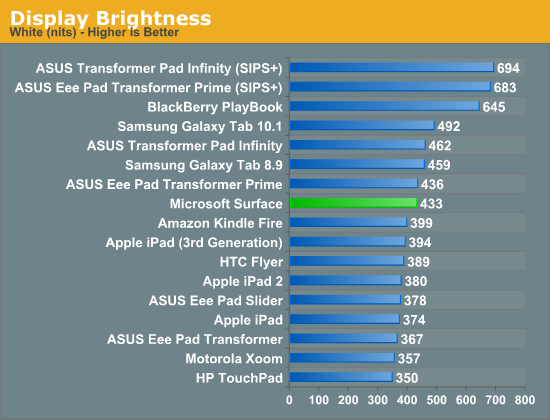
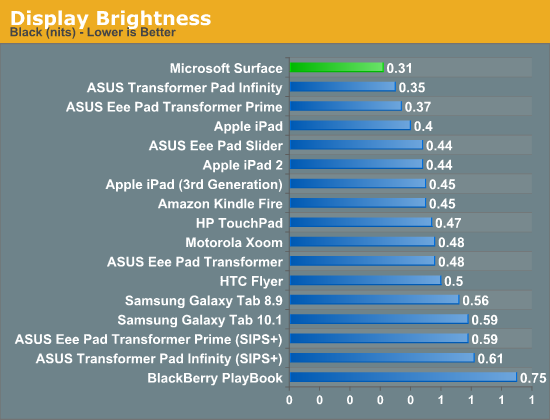
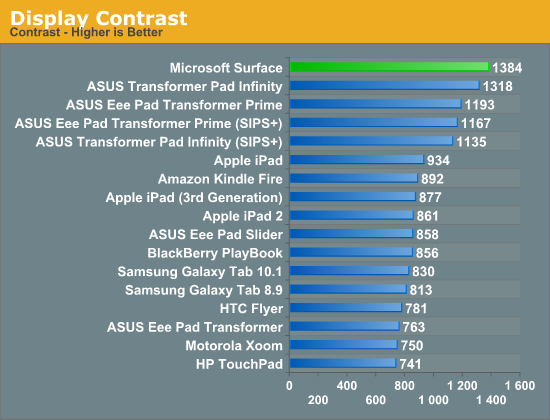
With the exception of text on web pages, the lower resolution Surface display isn’t overly bothersome. I would like something a bit higher resolution although I don’t know that matching Apple’s pixel density is absolutely necessary if Microsoft can deliver elsewhere.
Apple doesn’t just rely on resolution to sell the iPad’s Retina Display, it also happens to do quite well at accurately representing colors. I put Surface through AnandTech Senior Display Editor, Chris Heinonen’s excellent tablet/smartphone analysis workflow to see how well it did:
| CalMAN Display Comparison | ||||||
| Apple iPad (3rd gen) | Apple iPad 2 | ASUS Transformer Pad Infinity | Microsoft Surface | |||
| Grayscale 200 nits Avg dE2000 | 3.7333 | 1.3826 | 3.9881 | 3.6769 | ||
| CCT Avg (K) | 6857K | 6632K | 6632K | 6407K | ||
| Saturation Sweep Avg dE2000 | 3.193 | 6.8404 | 6.8404 | 7.3617 | ||
| GMB Colorchecker Avg dE2000 | 3.0698 | 3.8957 | 4.4177 | 5.3057 | ||
Saturation

Gamut
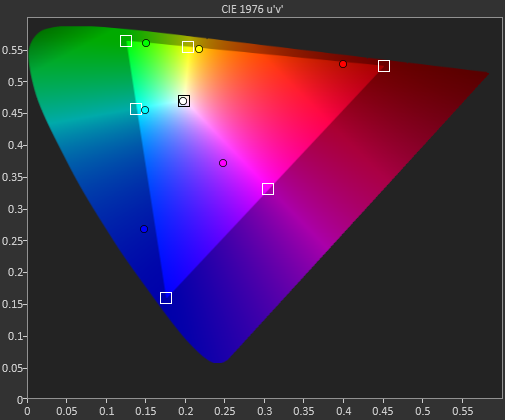
GMB Color Checker
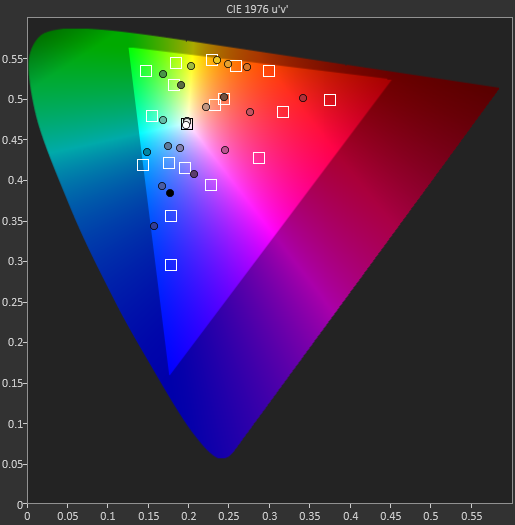
Grayscale accuracy is slightly better on Surface compared to the iPad, however the rest of the accuracy metrics show Apple’s tablet ahead of Surface.
This isn’t to say that Surface’s display is bad, in fact I think it’s quite good and I’d argue that it was never a problem in my testing, but it’s definitely not the best on the market today. I’m also not sure how much of this has to do with Microsoft’s panel selection vs. software calibration. None of my calibration tools work under Windows RT so I couldn’t really tell you.
I did reach out to Microsoft and they did say that some of my values in the charts below looked a little off. I’ll be rerunning data on another Surface sample as soon as I get a chance to.










235 Comments
View All Comments
kyuu - Tuesday, October 23, 2012 - link
Agreed, I'd like some clarification on this as well. I certainly hope it's a simple micro-HDMI that can be used with off-the-shelf adapters.ervinshiznit - Tuesday, October 23, 2012 - link
Anand,You mention that you would have liked to have seen the surface with x86. Is Windows RT only compatible with ARM or does it support x86 also? I realize it's just a compilation issue but I was under the impression that only ARM builds of Windows RT would ever be released by Microsoft.
MadMan007 - Tuesday, October 23, 2012 - link
Don't connect the hardware branding name 'Surface' and software. You are correct that WinRT=ARM only. But there will be Microsoft Surface devices using x86 hardware running full Windows 8.Will there be a budget Atom-based x86 Surface, in the same form factor as this one? I'm not sure off the top of my head, but that's probably what Anand meant.
ervinshiznit - Tuesday, October 23, 2012 - link
There have only been plans announced for the Surface Pro, which would include a Core i5 and run full Windows 8.I bring up the Windows RT=ARM only because Anand brought up the performance issue in the context of MS Office, and he said that he would have liked to see an Atom in the Surface instead of this ARM core. But then it wouldn't be able to run RT. And that would also mean no free Office 2013 since it's not included in full Windows 8
Ryan Smith - Tuesday, October 23, 2012 - link
Whether or not to include Office is basically arbitrary. Microsoft could include it with Surface Pro, as it's entirely up to them..The point to take home is not that RT doesn't run on Atom, but rather that Office on Surface is currently unusually sluggish. A SoC with better performance in lightly threaded situations (such as the Atom) would handle Office better based on what we're seeing.
Kevin G - Wednesday, October 24, 2012 - link
Reading through this review and others seems to point the problem at Office being sluggish and not necessarily the Tegra 3. Even on the PC side where far higher performing hardware exists, Office doesn't give the impression of a speed champion. I'd love to see Office compared on the Surface, Surface Pro and a decent laptop. Yeah, the deck would stacked in favor of the laptop winning but it'd be a good reference point for users as well as reviewing the idea of usability on each device. For example, I can see the utility of viewing and making a quick and simple change to an Excel spread sheet on a tablet but for heavy Excel use restricted to an on screen touch keyboard would likely result in levels of frustration that'd have me snapping the tablet in two.kyuu - Thursday, October 25, 2012 - link
That's the reason for the Touch/Type Covers...ervinshiznit - Tuesday, October 23, 2012 - link
Anand,You say
Application launch times are another thing entirely. Nearly every application I launched took longer than I would’ve liked on Surface. I can’t tell if this is a hardware issue or a software optimization problem, but application launches on Surface/Windows RT clearly take more time than on an iPad. I timed a few just to put this in perspective:
And after the : I expected a chart or something but there's nothing there.
JumpingJack - Tuesday, October 23, 2012 - link
I asked the same question, Ryan said they were overwhelmed with the iPad announcement, the 8350 launch, and his... He said Anand will fill in he info a bit later.michal1980 - Wednesday, October 24, 2012 - link
apple products didn't get short changed reviews... I wonder why.